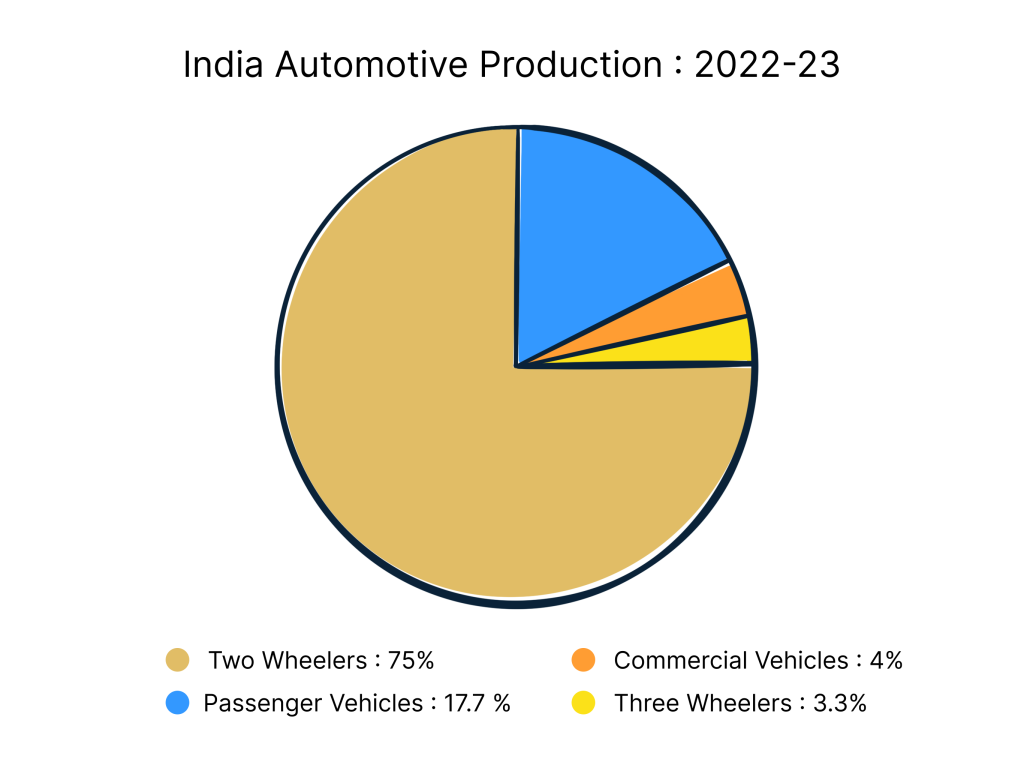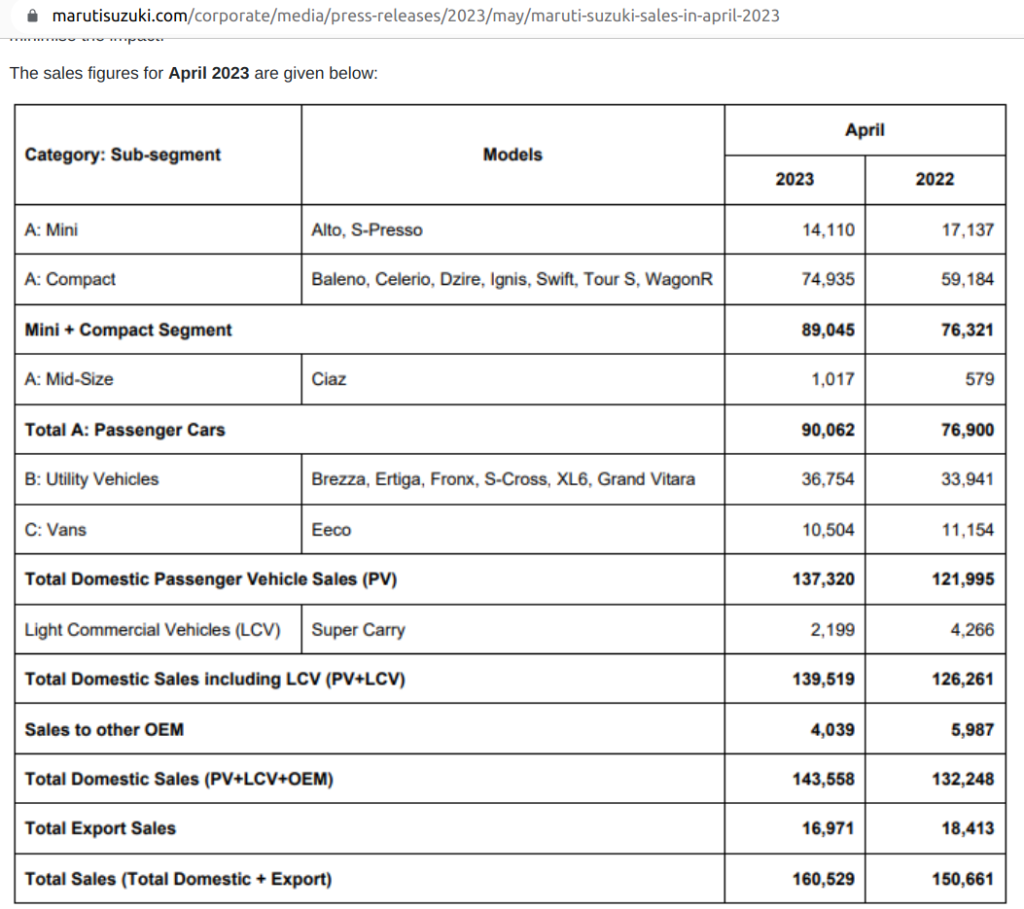6.1 – Automotive: An Introduction
The previous chapter was about the IT sector, a primarily B2B service business. This chapter will look at the automotive sector, mainly a manufacturing business. Sure, servicing is a huge part of the automotive sector, but it comes after the goods are produced and sold.
The automotive sector is an ecosystem. It comprises several moving parts. It has many sub-segments depending on the type of vehicles or customers. The vendors or suppliers to the automotive sector are also an industry of their own.
For example, a standard car is built of roughly 30,000 parts, including nuts and bolts. Engine, gearbox, chassis, axle, fuel tank, tires, batteries, airbags, glass, mirrors, handles, lights, and seats are just a few parts of a car that an amateur like me can think of. Today’s smart cars also have Bluetooth, wifi, digital screens, parking sensors, safety sensors, and GPS, among other features. Each of these parts is further made of several components.
Automobile manufacturers do not make these inputs themselves. Instead, they are mostly assembly lines. For example, Maruti Suzuki’s production plant in Manesar and Tata Motors’ plant in Pune are both assembly plants. They buy most parts and components from outside vendors. These vendors are called Original Equipment Manufacturers (OEMs). Each automobile company maintains multiple vendors for each component, making their vendor list run into thousands of names.
In this chapter, I endeavor to address all segments and ancillary sectors of the automobile industry. I will also dedicate separate chapters to some ancillary sectors. Let us first have a look at the landscape of the Indian automotive industry.
6.2 – The Automotive Sector in India
-
- In terms of volume, India surpassed Japan in 2022 to become the third-largest car market in the world. China sold 26 million cars, while the US sold nearly 14 million. India stood at a distant third with 4.6 million cars.
- Overall, India produced 26 million units in 2023. This includes two-wheelers, three-wheelers, and commercial vehicles apart from cars. India produced 26 million units in 2022-23. This pie chart shows a break-up of the Indian automobile industry.
- Two-wheelers account for the largest share of automobile sales in the country. Since a median Indian household is still not at a middle-income level, a larger share of two-wheelers than four-wheelers is justified. (Did you know that the demand for two-wheelers is usually expected to be strong in the years when the monsoon season was good?)
- Passenger vehicles include cars and vans. While we worry about traffic snarls in all Indian cities, on average, only one among twelve houses owns a car in India. That is roughly 8% of households. This number is over 50% in the developed countries.
- Trucks and buses make up the commercial vehicle segment. Commercial vehicles exhibit different demand patterns than consumer vehicles.
- Three-wheelers make a very small amount of the overall vehicle production distribution. They are often seen as a blessing in crowded metro cities.
-
- India is the largest tractor manufacturer, second-largest bus manufacturer, and third-largest heavy truck manufacturer.
- The preference for diesel cars is on the decline. From nearly 60% of the total industry volumes around 2013, diesel cars now account for less than 20%.
- While Internal Combustion Engine (ICE) vehicles make up most of the total automobile market, the adoption of electric vehicles is fast accelerating. In terms of sales, the Government of India wants 30% of all cars and 70% of all commercial vehicles to be electric by 2030.
By the way, ICE vehicles are regular engine vehicles powered by petrol, diesel, or gas. ICE vehicles run the combustion of fossil fuels. Electric vehicles do not run on combustion.
6.3 – Analyzing Business Performance
We will focus on volumes and product mix to understand the business performance. Let’s enlist the parameters.
-
- Production volume: It is the number of cars or vehicles manufactured in a quarter or month. Steady growth in production volumes is preferred. The automaker might also add notes to their production report. These notes could give insights into the business. For example, in the notes to this production volume table, Maruti Suzuki mentioned how it could not hit the production target due to a shortage of electric components.
While all automobile companies report volume sales, very few report production volumes in a comprehensive manner.
This is a snapshot from SIAM’s website. It shows production volumes across vehicle types.
-
- Sales Volume: It is the actual number of units sold to customers. This snapshot is from Maruti Suzuki’s monthly sales report. If you compare this image with the production snapshot, you will notice that Maruti Suzuki sold almost 15000 more units than it produced in April 2023. But in April 2022, it sold about 7000 lesser units than it produced in the same month.
An automaker might sell more or fewer units than the number produced. Continuously lower sales volume than production could indicate inventory build-up. Continuously higher sales than production cannot last for long. You cannot sell what you have not produced. But higher sales numbers suggest increasing demand.
Higher demand has to be met with higher production. This may not be possible if the production capacity is already fully used. If the automaker is convinced that the demand will continue, it can add capacity. Capacity addition comes with significant capital expenditure. Debt levels could also rise to fund capital expenditure. All automobile manufacturers report sales volume every month.
-
- Revenue growth vs volume growth: In this table, I have collated the revenue and sales volume numbers of Maruti Suzuki for the past five years. In most periods, revenue growth is more than volume growth. This could mean one or both of the following.
- The average selling price per unit is growing faster than volume growth.
- Maruti Suzuki is selling higher-priced cars more than lower-priced ones.
- Revenue growth vs volume growth: In this table, I have collated the revenue and sales volume numbers of Maruti Suzuki for the past five years. In most periods, revenue growth is more than volume growth. This could mean one or both of the following.
Either way, the average realization is growing. “Realization” is the money Maruti Suzuki is making per car.
If realizations were falling, revenue growth would be slower than volume growth. This is a more problematic feature. The carmaker may be losing brand value and is forced to sell at lower prices.
-
- Product mix: Product mix refers to a company’s portfolio of various products. In the case of an automobile manufacturer, it is the various types and the range of vehicles it sells. Maruti Suzuki sells cars at various price points. Tata Motors sells cars and trucks at various price points. Mahindra sells cars, trucks, and tractors. Eicher sells bikes, trucks, and buses. Hero Motocorp sells gear and non-gear two-wheelers.
As shown in the previous point, if Maruti Suzuki sells more higher-priced cars than lower-priced ones, it reaps the benefits of a good product mix. Profit margins on higher-priced products tend to be higher.
This applies to all industries. If you buy Lifebuoy Soap, HUL wants you to buy Dove. If you have a Super subscription, Hotstar wants you to buy a Premium subscription. If you have a Swift, Maruti wants you to upgrade to Swift Dzire.
Let’s compare these metrics for some automobile companies.
These metrics are all about revenues. A business needs to keep its costs in check to be profitable. Cost, efficiency, and profitability ratios for automotive companies are the same as what we have covered in the Fundamental Analysis module on Varsity.
The automobile business is asset-heavy. The chance of high debt on the balance sheet is also high. Therefore, when studying the automobile sector, I would also study the debt-equity and other leverage ratios from the fundamental analysis module.
That said, we must also study what and how external elements influence the sector. For the sake of not making this chapter too heavy, we will discuss the rest in the next chapter. It will primarily focus on what factors drive costs and impact the efficiency of automakers.
Happy reading! 🙂
Key Takeaways:
-
- India is the third largest market globally for passenger vehicles. The government is giving a major push to EVs.
- Major performance indicators of automobile companies are production volume, sales volume, revenue growth vs volume growth, and product mix.
- Most automakers operate assembly lines. They buy all components from suppliers.
- Since an average car is made of almost 30,000 components, managing thousands of suppliers becomes critical.
- The business performance of automakers is mainly compared on the basis of revenue, volume produced, and volume sold figures. A faster revenue growth than sales volume growth could mean improving margins.
- Product mix also has a bearing on the performance. Selling higher value automobiles is generally expected to grow margins.









auto ancillary sector analysis kb tk aayegaa?
We will try to bring it soon. 🙂
how can we analyze growing industries and sectors which could give us realistic returns in near future for ex. green energy ,electric vehicles,alternative fuels etc.
Hi Karnakya,
Most new industries have unproven revenue or business models. Adoption of their technologies or products is also uncertain. Therefore, instead of a structured analysis, you will have to look at pseudo-indicators such as number of users, number of outlets, etc. There is no sure shot answer to this. When Zomato and Paytm IPOs came, they did not have a listed peer for analysts to use as a reference. Each applied their own independent approach.
Also, Warren Buffett would say that he always knew technology was going to greatly benefit humans, he just was not sure which companies would actually deliver or fail. That is why he stayed away from tech stocks for the longest time. Similarly, these new industries will do well, but it might be difficult for now to identify which companies in these industries would do well. 🙂
What will be the Key performance Indicators (KPIs)of the Automobile Sector?
For an investor analyzing the automobile sector using publicly available data, factors mentioned in section 6.3 of this chapter are the most easily accessible KPIs.
Lead time, utilization rate, supplier network and score, error rate, etc. are also KPIs but might be difficult to get for all the players in the sector.
Therefore, other external factors that may impact the operations and performance of automobile companies and may give some idea about their business are elaborated in Automobiles (Part 2), the next chapter.
Hi, In the revenue – sales table of different companies, the sales of M&M was high but revenue was low…in products segment i can see that Mahindra produces passenger,commercial,farm vehicles which may cost high…does it means that segment took a hit?? is this how we have to analyse??
Yes Siva, it is possible that the segment took a hit. But you have to verify that. It is also possible that their two- and three-wheelers did exceptionally well which would mean higher volumes but lower revenues. So when you think a segment took a hit or did exceptionally well, you must dig deeper into finding out what really happened? Check their segment revenues and results in the notes section. That could shed some light. 🙂
Great content Vineet,Keep Going:)
Thank you, Raghu Ram!!